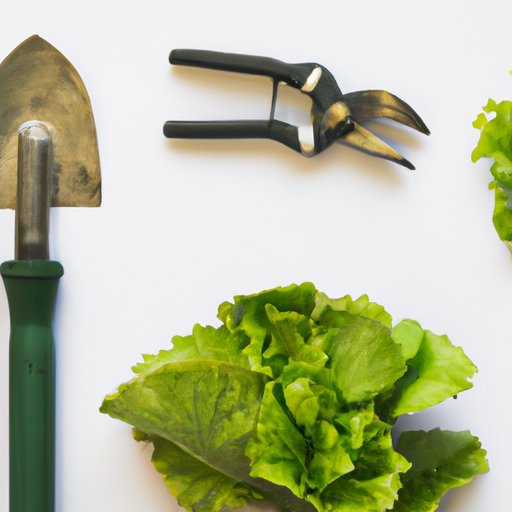
Introduction
Lettuce is a great crop to grow in your garden as it is easy to grow and provides fresh, crisp greens for your meals. However, knowing when and how to harvest lettuce can be tricky. In this article, we will provide a step-by-step guide to harvesting lettuce, tips for maximizing your yield, and the benefits of consuming freshly harvested lettuce. We will also discuss sustainable harvesting practices and offer solutions to common problems that people face while harvesting lettuce.
Step-by-Step Guide to Lettuce Harvesting
Knowing when to harvest your lettuce is crucial for maximum flavor and nutrient content. The best time to harvest lettuce is in the early morning before the sun hits the leaves. This is when the lettuce is at its freshest and most flavorful. To harvest the lettuce, use a sharp knife or scissors to cut the head off at the stem, leaving about an inch of stem attached to the head. If you plan to harvest the leaves instead of the whole head, choose the outermost leaves and leave the inner leaves to continue growing. Once you’ve harvested your lettuce, be sure to rinse it well in cold water and let it dry on a clean towel. Then, store it in a plastic bag in the refrigerator for up to 7 days.
The Best Tools for Lettuce Harvesting
Using the right tools for lettuce harvesting can make the process easier and more efficient. A sharp, serrated knife and a cutting board are essential for harvesting lettuce. A lettuce spinner is also a handy tool for washing and drying the greens. When using the knife, be sure to use a sawing motion to avoid crushing the leaves. When using the lettuce spinner, fill it with cold water and spin the leaves lightly to remove any dirt or debris.
Tips for Maximizing Your Lettuce Yield
Getting the most out of your lettuce crop is important for a successful harvest. To maximize your yield, plant your lettuce in an area with plenty of sunlight and well-drained soil. Proper spacing between plants is important, with at least 12 inches of space between each head to allow room for growth. Continual harvesting of outer leaves instead of waiting for the heads to fully mature will encourage new growth and prolong the harvest. Regular fertilization with organic materials such as compost will also help to boost the yield of your lettuce crop.
The Nutritional Benefits of Freshly Harvested Lettuce
Freshly harvested lettuce is not only delicious but also packed with nutrients. Lettuce is a great source of vitamins and minerals such as vitamins A, C, K, and folate. Consuming freshly harvested lettuce can provide even higher nutrient content compared to store-bought lettuce, which loses nutrients over time. To fully appreciate the flavor and nutritional benefits of freshly harvested lettuce, try making simple salads like Caesar Salad or Greek Salad.
Sustainable Lettuce Harvesting Practices
Sustainability is an important aspect of lettuce harvesting. Using organic fertilizers and compost instead of synthetic chemicals is an eco-friendly way of promoting healthy soil and avoiding the harmful effects of pesticides on the environment. Drip irrigation systems are another sustainable method for watering lettuce, as they use less water and reduce the risk of overwatering. Additionally, consider using reusable bags or containers to store and transport your harvested lettuce to limit plastic waste.
Troubleshooting Lettuce Harvesting Problems
Common issues that gardeners face while harvesting lettuce include bolting early, pests eating the harvest, and yellowing leaves. Bolting occurs when the plant matures quickly and produces a flower stalk, which can lead to bitter-tasting leaves. To avoid this, plant lettuce in cooler temperatures and cover them during hot weather. Taking preventative measures like using row covers or netting can protect the crops from pests. Yellowing leaves could be a result of overwatering or underwatering. Adjusting the watering schedule can help to prevent this problem.
Conclusion
Harvesting lettuce can be an enjoyable and rewarding experience if done with proper planning and techniques. By following the step-by-step harvesting guide and our tips for maximizing your lettuce yield, you can have a successful lettuce harvest. Remember that harvesting lettuce is not only good for your health but also for the environment, by promoting sustainable and eco-friendly practices.




